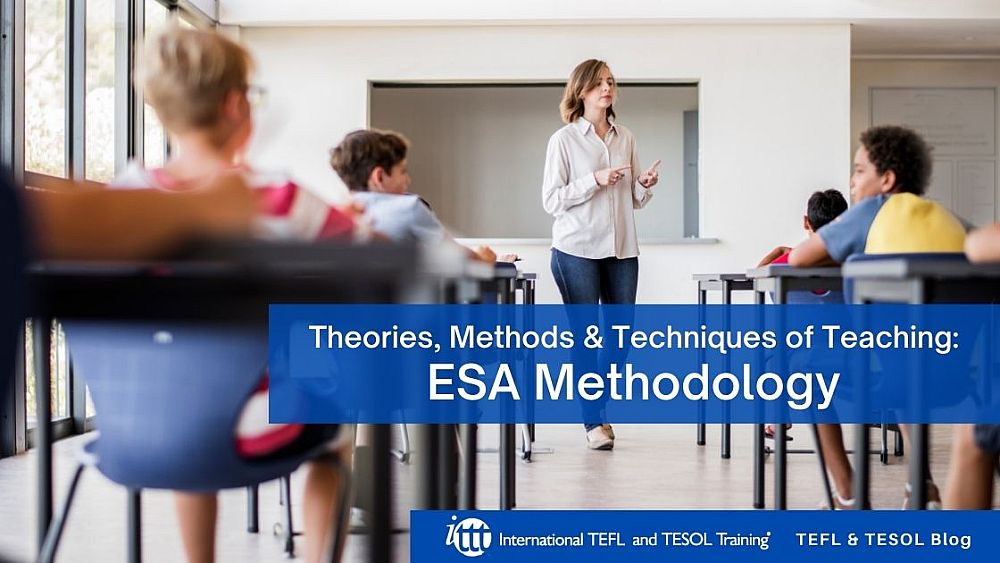Theories, Methods & Techniques of Teaching - ESA Methodology

ESA is a three-stage methodology where each of the letters represents a particular phase of the lesson. The first one being called the Engage phase, the second the Study phase and the final one the Activate phase.
Table of Contents
Watch the video about this topic
What are the positive factors in the use of the ESA methodology?
Are you ready to teach English as a foreign language?
Check out what our course grads say in our many video testimonials!
Watch the video about this topic
In 1998 Jeremy Harmer published a book called, How to teach English and basically what Harmer did as a background to his book was to look through all of the different methodologies that have come about over the last 300 or so years.
He highlighted for each of those methodologies, what was good about it, what was positive and what didn't appear to work. He then put all of the positive things into a melting pot and came out with this methodology which he called, Engage Study Activate (ESA).
It's a three-stage methodology where each of the letters represents a particular phase of the lesson. The first one being called the Engage phase, the second the Study phase and the final one the Activate phase.
The Engage phase of an ESA lesson has one particular purpose and that is to get the students talking and thinking in English. We can go back to the idea of the effective filter and it is said that when students are relaxed then that will improve their chances of learning. The idea of getting the students talking and thinking in English in the first part of the lesson is just to relax them and to get them involved. This typically achieved by the use of some form of simple communicative game and then we move into the actual teaching part of the lesson which is called the study phase.
The Study phase has two parts to it, the first part is known as the study board work and that is where the actual teaching takes place. In this part of the lesson the teaching which is mainly through elicitation is done. Once we've completed that phase of the lesson we need to check with the student actually understand what they have just been taught. To achieve that we then ask the students to complete a series of targeted activities that are focused towards the teaching point. This is usually done through the use of worksheets.
Finally, the Activate stage which is to make sure that they actually understand and can use the language. In order to be able to use the language in a communicative way you need to move beyond the actual knowledge and put it into a realistic context. That is exactly what the activate phase does, this phase of the lesson sets up some form of scenario or situation where the students can use the language knowledge that they've just learned and put it into a realistic context.
What are the positive factors in the use of the ESA methodology?
The first is that it requires communication, the activate activity and indeed the study activities require the students to actually talk to each other.The second positive thing about it is that it works and it works for all levels, from our beginners up to our upper intermediate students this particular methodology can be used.
Some negative factors about it might be that it can become predictable. If you follow that same structure of ESA every single lesson with your students then they will get to know what is coming next. However Harmer came up with a way around that and that in terms of two further styles of lesson that do not follow the ESA structure.
One potential negative for some particular countries is that the activate activity requires students to talk to each other (often all getting up an moving around) and if all your students are talking to each other, then your classroom can become noisy and potentially in certain countries this could be a problem.
Are you ready to teach English as a foreign language?
Apply now & get certified to teach english abroad!
Speak with an ITTT advisor today to put together your personal plan for teaching English abroad!
Send us an email or call us toll-free at 1-800-490-0531 to speak with an ITTT advisor today.
Related Articles:
- Top 10 Cities in Europe with the Highest Demand for English Language Teachers
- 5 Reasons To Take A TEFL Course Right Now - Even If You Are Not Leaving Yet | ITTT | TEFL Blog
- All the Documents You Will Need to Teach English Abroad
- The Impact of Positive Motivation on an ESL Classroom
- You're Never Too Old to Change Your Life and Do a TEFL Course | ITTT | TEFL Blog
- Getting Student Placement Right - The Best Desk Arrangements for EFL Students



